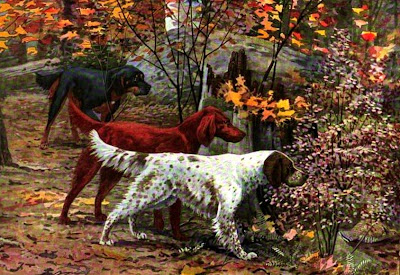The English, Irish, and Gordon setters are almost too well known to need any physical description. Fashions have changed somewhat, and will probably continue to do so, in these as in other popular breeds. Still, the needs are so definite, and performance is such a necessary foundation for appearance, that the setters will probably never deviate very widely from the present standard, except in minor points attained by crossing the known types.
It is doubtful if any serious breeder would trust other than setter blood in these already very beautiful and useful dogs. In this country no dog is so well fitted for hunting grouse, pheasants, quail, and feathered upland and woodland game in general. In comparing the three principal types, the English is the largest and strongest, and is largely white, with liver, tan, orange, or black blotches and "ticking." The Irish is the lightest and most finely drawn, and is all rich mahogany tan ; he has a more high-strung disposition than either of the others, and is rather more nervous and subject to temperamental weaknesses, though when well trained and intelligently handled is unsurpassed as a field and hunting dog.
The Gordon is a north British development, to be used chiefly on the red grouse of the heathery uplands, and is black, with deep tan chops, ear-linings, chest, belly, feet, and feather, and the characteristic tan spots over the eyes and on the cheeks. For several years he was bred to a very delicate, slender-headed type : he was then a very affectionate and beautiful creature, but lacked the staunchness such a hunting dog must have.
The present standard dictates a dog of almost exactly the conformation of the English setter : wide across the forehead, strong, fairly broad, and very deep in the chest, with plentiful bone in legs and good, hard, compact feet. In this country, where the autumn woods abound in russet browns and deep shadows, the solid red and the black and tan dogs arc harder to follow with the eye than those with a fair amount of white ; hence the English setter and the mainly white pointer are favorites among the hunters, though the Irish has many adherents among those desiring a beautiful and companionable dog. The Gordon is nearly obsolete in this country.
known by the kennel names of their breeders, such as Belton and Llewellyn setters. These are excellent quality dogs, being somewhat more of the build of the Irish setter and considerably lighter and more delicately put together than the staunch old English setter. Both are white, with much tine ticking of black which in the long white coat has a bluish appearance.
All setters should show quite a marked stop, have full, sympathetic, and intelligent eyes, soft, fine, nearly straight hair, a full feather along the back of all four legs, as well as from the lower side of the tail. They should be built much like a pointer, except that they lack the springy arched quality of legs and back, being rather more careful, but much less rapid, workers than these rangers of the open fields.
The stifle should be straight from front or back instead of free and outturned.
Under his soft and rather silky coat, the setter should be hard, finely muscled, and compact, and none of these dogs should be allowed to get fat and lazy, as they so often become in the hands of affectionate owners. No dog has a more wheedling way with him, and it takes a rather firm nature to withstand his wiles. '
From The Book of Dogs: An Intimate Study of Mankind's Best Friend By National Geographic Society (U.S.), Louis Agassiz Fuertes, Ernest Harold Baynes Published 1919. 109 pages Original from Harvard University.
This image (or other media file) is in the public domain because its copyright has expired.
This applies to the United States, where Works published prior to 1978 were copyright protected for a maximum of 75 years.
See Circular 1 "COPYRIGHT BASICS" from the U.S. Copyright Office. Works published before 1923 are now in the public domain In the United States,
This inage is also in the public domain in countries that figure copyright from the date of death of the artist (post mortem auctoris in thi case Louis Agassiz Fuertes (1874 – 1927) and that most commonly runs for a period of 50 to 70 years from that date. If your use will be outside the United States please check your local law.
Tags: Public Domain Clip Art and clip art or public domain and English Setter or Irish Setter and Gordon Setter













No comments:
Post a Comment